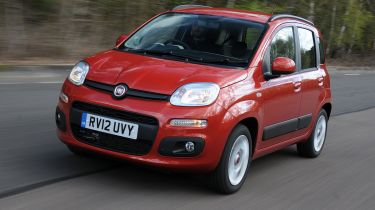Fiat Panda 900cc TwinAir
We see if turbo two-cylinder baby delivers on promise of fun, practicality and style?
The Panda has been a huge hit for Fiat ever since the original model burst on to the city-car scene in 1980. The company is anxious to continue that success story with the MkIII, but the car has received a lukewarm reception so far.
We tested the big-selling 1.2-litre petrol version back in March, and while we loved its grown-up dynamics and desirable style, the Easy trim’s miserly standard equipment meant that the Panda was denied its first victory by the cheaper and better-equipped Hyundai i10.
However, it’s now the range-topping Lounge model’s turn with the 875cc twin-air engine, and from the outset it looks a more serious contender. It has the same tall shape and smooth curves as lesser versions, but crucial extras like 15-inch alloys, body-coloured door handles and bumper-mounted foglights give it a more upmarket look.
The rear lights now form part of the car’s C-pillars, but are placed higher up to avoid being damaged in minor scrapes. They also include the same Panda motif that appears on the wheel centre caps, bootlid and even the interior door panels. These quirky styling flourishes give the Fiat plenty of character and help set the tone for what’s in store inside.
Used - available now

2020 Suzuki
SX4 S-Cross
46,548 milesManualPetrol1.4L
Cash £11,997
2020 BMW
X2
44,368 milesAutomaticPetrol2.0L
Cash £14,997
2021 SEAT
Ibiza
18,736 milesManualPetrol1.0L
Cash £14,897
2023 Land Rover
Discovery
13,183 milesAutomaticDiesel3.0L
Cash £57,500Everything from the deeply recessed dials to the heater controls and gearlever has the same rounded-off square shape. The Lounge trim is a big improvement over the stripped-out base model in terms of equipment, with air-conditioning, remote central locking and a height-adjustable steering wheel all included as standard.
Our car was also fitted with the £400 optional Techno Pack, which adds Bluetooth, steering-wheel audio controls and a removable TomTom Live touchscreen sat-nav that plugs into the dashboard.
Despite being £1,400 cheaper than the £12,650 Micra, the robustly built Panda definitely feels like the more upmarket of the two, although there are still some hard plastics to be found low down on the dash.
The high driving position and large glass area mean forward visibility is great, but start loading the Panda with passengers and you’ll see that interior space is at a premium. Taller people will find their knees brushing the back of the seats in front, and a seatbelt for the narrow middle seat is a £50 option.
From September onwards, Fiat will offer the Panda with a sliding rear bench that’ll swell the standard boot size from 225 litres to 260 litres, but until then it loses out to the more flexible Micra. Flip down the seats and there’s 870 litres of space – yet while that’s decent for a city car, it’s a lot smaller than a full-sized supermini.
Still, the compact dimensions and light, accurate controls make the Panda easy to drive in town. Suspension tweaks and extra sound deadening mean it’s more comfortable and refined on the motorway than the old car – but there’s always an audible hum in the cabin from the tiny two-cylinder engine.
The TwinAir only develops 84bhp – that’s 13bhp less than the Micra – but it rarely feels slow. The small turbocharger provides plenty of mid-range grunt and the Panda went from 30-50mph in third gear in only 5.5 seconds.
The engine makes a fantastic noise, too, but can feel slightly sluggish at low revs. Pushing the ECO button on the dash slashes torque output from 145Nm to 100Nm in a bid to cut fuel costs.
But you’ll struggle to match the TwinAir’s official fuel economy figures, especially if you enjoy all the performance on offer – we returned a shocking 32.7mpg on a varied route. Owners will probably manage better figures, but if your priority is low fuel bills, then go for the Multijet diesel model.
Regardless of what engine it uses, the Panda’s composed and tidy handling runs rings around the lead-footed Micra in corners, with less body roll and better grip in all conditions. What’s more, even when fitted with the same level of kit, the Fiat manages to undercut the Nissan by £300 – and both cars have equally low running costs.
The Panda won’t hold on to its value as well, though; after three years, it’s set to retain only 37.8 per cent of its purchase price. Still, in this trim, it makes for a compelling package.
Details
Chart position: 1
WHY: Larger exterior dimensions should make the Panda more practical than ever, while the characterful TwinAir engine from the 500 promises frugal fun.







